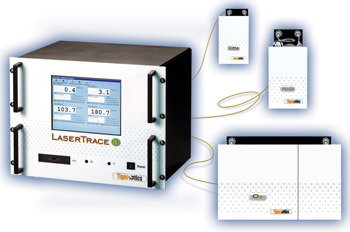- News
5 July 2011
Tiger Optics launching LaserTrace 3 trace gas analyzer at Semicon West
Continuing to expand the capabilities of its patented CW-CRDS technology, in booth 1027 at next week’s Semicon West 2011 trade show in San Francisco (12–14 July) Tiger Optics LLC of Warrington, PA, USA plans to introduce the LaserTrace 3 trace gas analyzer, which can detect moisture, oxygen, methane, and other analyte contaminants at limits that are more than two times (2x) lower than previous generations of the product line.
Tiger sells laser-based trace gas analyzers to semiconductor manufacturers, tool manufacturers, purifier manufacturers and the gas companies that supply bulk and specialty gases to the industry. In semiconductor manufacturing, contamination in process gases has a destabilizing effect and negatively impacts deposition processes. As a result of as little as single-digit parts-per billion impurities in process gases, product yields are reduced. To remedy this problem, the LaserTrace 3 allows users to monitor for intrusions at levels that were never previously available, it is claimed.
 “Semiconductor manufacturers have adopted our patented CW-CRDS (continuous-wave cavity ring-down spectroscopy) technology due to the superior detection range, ease of use, the lowest total cost of ownership in the industry, and the fact that this is an absolute technology — no calibration gases are required,” claims founder & chief executive Lisa Bergson. “In order for our customers to meet targets for the 15-year International Technology Roadmap for Semiconductors (ITRS), they need to monitor their process gases at ever increasing levels of purity,” she adds. “The technological advancements of the LaserTrace 3 are a result of Tiger Optics’ on-going investment in R&D... our customers will now be able to realize a two-fold improvement in their detection limits.”
“Semiconductor manufacturers have adopted our patented CW-CRDS (continuous-wave cavity ring-down spectroscopy) technology due to the superior detection range, ease of use, the lowest total cost of ownership in the industry, and the fact that this is an absolute technology — no calibration gases are required,” claims founder & chief executive Lisa Bergson. “In order for our customers to meet targets for the 15-year International Technology Roadmap for Semiconductors (ITRS), they need to monitor their process gases at ever increasing levels of purity,” she adds. “The technological advancements of the LaserTrace 3 are a result of Tiger Optics’ on-going investment in R&D... our customers will now be able to realize a two-fold improvement in their detection limits.”
Tiger says that, since its debut in 2003, the LaserTrace platform has been widely accepted for semiconductor applications. The multi-species, multi-point, multi-gas product line accommodates up to four sensor modules in a standard 19-inch rack, or permits placement of individual sensor models as far as 200 feet from the computerized control unit. In 2005, the firm launched its LaserTrace O2 as the world’s first laser-based, trace oxygen analyzer to detect parts-per-trillion levels in ultra-high-purity gases. In 2008, the LaserTrace+ made possible the lower detection limit (LDL) of 200 parts-per-trillion, affording the widest dynamic range of any dedicated analyzer currently in the market, it is claimed.
